Key Takeaways
- Engaging children in trampolHopscotch hopscotch can improve their balance, coordination, and strength, which are vital for gross motor skill development.
- Martial arts and dancing activities enhance coordination, body awareness, and overall physical fitness in children aged 4-6.
- Balloon and bubble activities, along with playground adventures, can promote agility, spatial awareness, and proprioception, which are crucial for gross motor skills.
- Building obstacle courses at home is a fun and effective way to boost a child’s gross motor skills, problem-solving abilities, and physical confidence.
- Animal imitation games and balance challenges can significantly improve children’s coordination, body position sense, and core strength.
Exploring Trampolines
Delving into the world of trampolines, these dynamic play tools not only provide entertainment for 4 – 6-year-olds but also significantly improve their balance, coordination, and muscle strength, thereby promoting gross motor skill development. Each bounce on the trampoline requires the child to engage and control their core and limb muscles, fostering muscle strength. The need to maintain balance while bouncing stimulates their proprioceptive sense and equilibrioception, enhancing their body’s balance and spatial orientation abilities.
Trampolines are not only a fun activity but also a vital component of a sensory diet for children. The sensory feedback received during trampoline play aids in calming and focusing, which is particularly beneficial for children with a sensory processing disorder. Indoor trampoline parks also provide a socializing platform, fostering social development.
Opting for a mini-trampoline for supervised home use can be an effective way to promote regular trampoline activities. However, safety is paramount; having a jump bar and adhering to safety rules can prevent potential injuries. Regularly incorporating trampoline play can help children in this age group enhance their motor skills and overall physical fitness, proving it to be an engaging and beneficial play tool.
Fun With Hopscotch
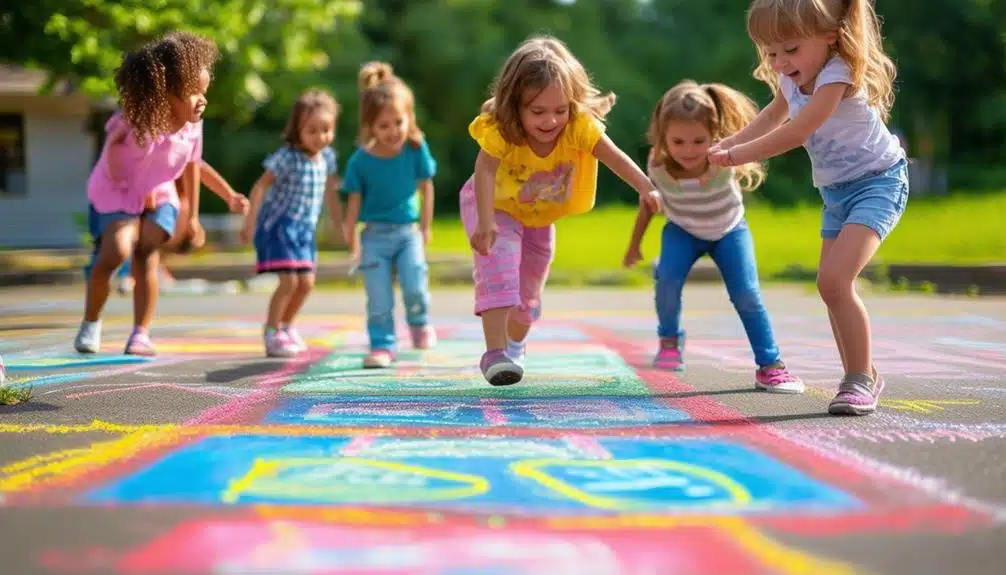
Moving from trampolines, another effective activity for enhancing gross motor skills in children aged 4-6 is the time-honored Hopscotch Hopscotch. This classic game promotes balance, coordination, motor planning, and body awareness, all of which are essential skills for the physical development of young children.
Hopscotch requires children to hop, jump, and balance on one foot over a series of numbered squares. This game not only heightens their motor planning but also augments their body awareness by compelling them to control their bodies’ movements precisely. Furthermore, the inherent challenge of maintaining balance while hopping on one foot or jumping to the next square can significantly improve their equilibrium and coordination.
In addition to the physical Hopscotch, Hopscotch offers children an opportunity to practice number recognition and sequencing, thereby integrating cognitive development with physical activity. The game can easily be set up using chalk outdoors or tape indoors, allowing for flexibility and convenience.
Martial Arts for Balance
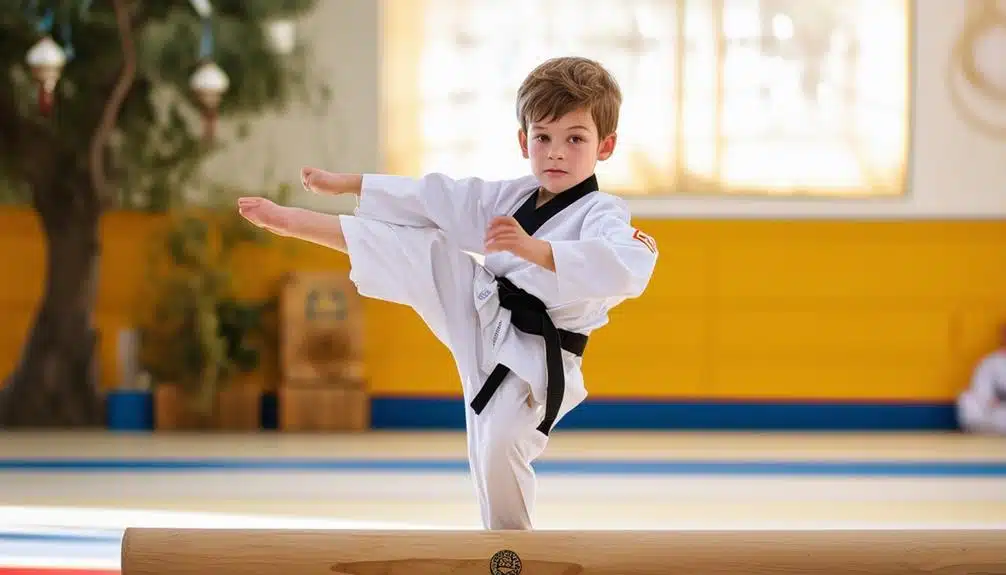
Shifting our focus to martial arts, it is essential to mention that these classes have proven to be highly beneficial in improving balance in children aged 4-6 years, primarily by developing strength in their arms and legs.
A significant aspect of martial arts involves actions such as kicking and punching. These deliberate movements engage core muscle groups, thereby promoting balance and enhancing motor skills. The increased core strength not only aids in maintaining balance but also in daily activities requiring stability and coordination.
Furthermore, martial arts training can be especially beneficial for children with sensory issues and ADHD. These classes teach body awareness and coordination, skills that are often challenging for these children to master. By focusing on physical control and disciplined movement, these classes can provide a supportive and structured environment for improving motor skills and balance.
Moreover, participation in martial arts from a young age can have long-term benefits on a child’s physical development. It aids in the development of gross motor skills, which are essential for everyday functions such as walking, running, and jumping. Therefore, martial arts offer a holistic approach to developing balance, improving motor skills, and boosting overall physical fitness in children aged 4-6 years.
Playground Adventures
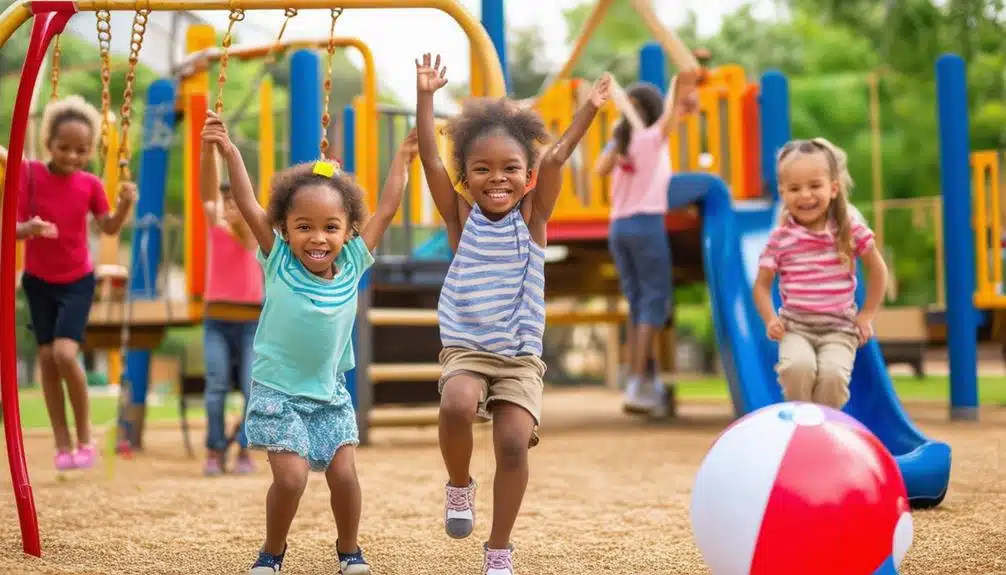
While martial arts offer a structured environment for motor skills growth, unstructured play, as seen in playground escapades, also provides various chances for children aged 4-6 to improve their balance, coordination, and strength. The carefree nature of playground escapades not only ignites children’s creativity but also tests their physical abilities.
Exploring various playground structures and terrains hones gross motor skills. For example, hanging from monkey bars or ascending rope ladders can significantly boost upper body strength and coordination. These activities require children to manage their body weight, thereby promoting strength and agility.
Balance beams introduce another valuable aspect of playground escapades. As youngsters walk or jump along these beams, they practice balancing, a crucial gross motor skill. Additionally, leaping off platforms enhances proprioception, aiding children in comprehending the positioning and movement of their bodies in space.
The diversity inherent in playground escapades thus helps engage different muscle groups, improving overall physical growth. Furthermore, these activities are engaging and fun, motivating children to hone these essential movement abilities consistently. Therefore, playground escapades play a vital role in motor skills development in 4-6 year olds.
Balloon and Bubble Activities
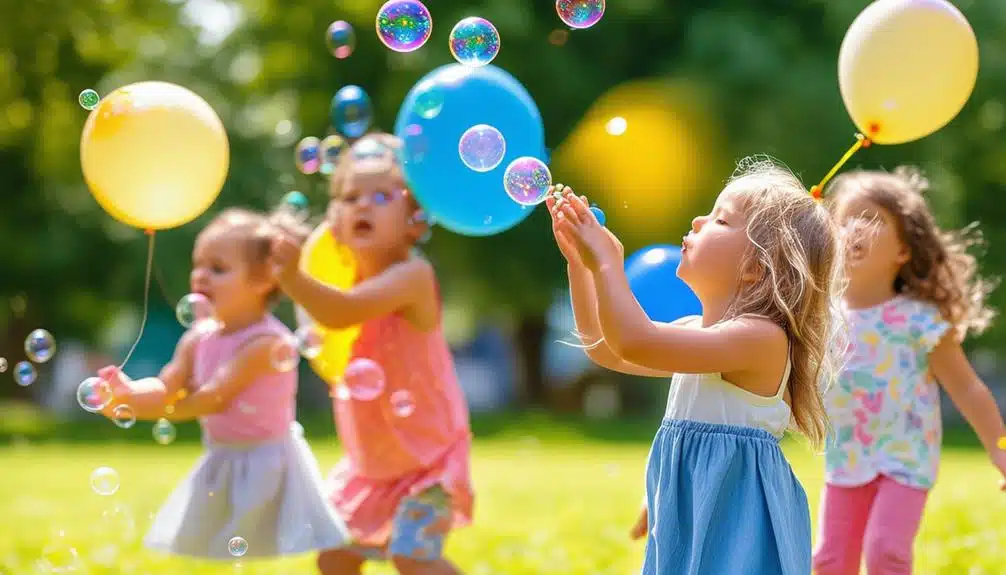
In addition to playground adventures, balloon and bubble activities present an unforeseeable yet thrilling avenue for children aged 4-6 to enhance their gross motor skills further. These activities, while seemingly simple, require a host of coordinated movements that promote balance, agility, and overall physical development.
Chasing bubbles or popping balloons, for instance, requires running, jumping, and sudden shifts in balance. This unpredictability enhances overall coordination, as children must constantly adjust their movements to meet changing circumstances. Balloon play, specifically, can easily be structured into games such as balloon volleyball. These types of games challenge children to use their bodies in novel ways, such as dodging or kicking, further supporting gross motor skill development.
Moreover, incorporating balloons and bubbles into playtime can be a fun and effective way to support the physical development of 4-6-year-olds. The allure of these activities lies in their simplicity and the joy they bring to children. Yet, behind the scenes, they are actively engaging children in movements that are fundamental to their development. This makes balloon and bubble activities a valuable asset in promoting gross motor skill development.
Tricycles, Scooters, and Pedal Cars
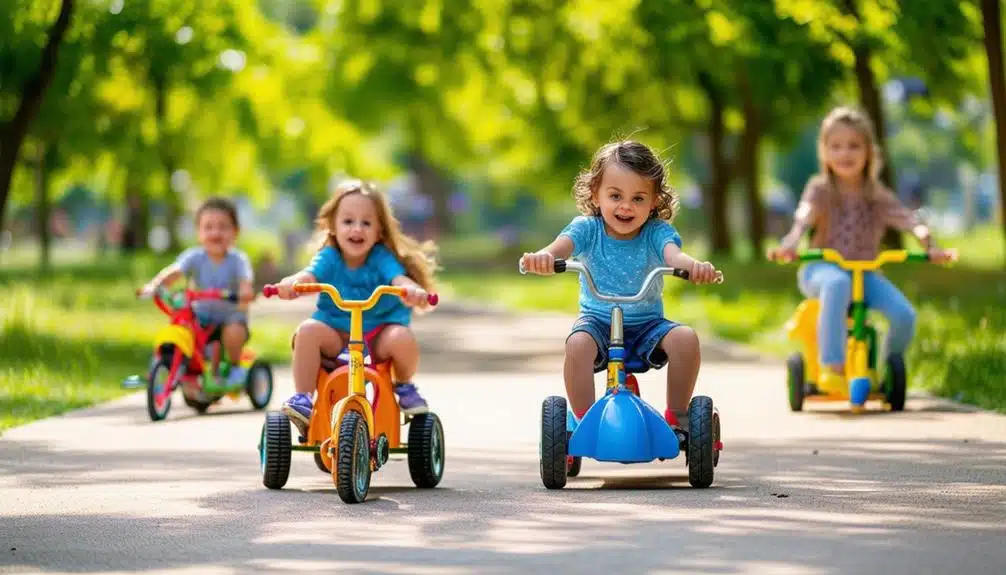
Exploring the world on tricycles, scooters, and pedal cars offers an exciting opportunity for children aged 4-6 to practice balance, coordination, and mobility, thereby greatly enhancing their gross motor skills. These vehicles serve as excellent tools for children to gain confidence in their physical abilities while also having fun.
| Activity | Equipment | Benefits |
|---|---|---|
| Riding | Tricycles, Scooters, Pedal Cars | Practice balance, coordination, and mobility |
| Obstacle Courses | Cones, Chalk | Enhances spatial awareness, navigation skills |
| Safety Practices | Helmets | Instills safety consciousness |
Tricycles, often equipped with handles, provide support while the child learns to pedal and steer. Scooters require balance and coordination, preparing the child for the more complex task of bike riding. Pedal cars, like tricycles, allow for practice in pedaling and steering but on a larger scale, offering a different challenge.
Creating obstacle courses gives children the opportunity to navigate and maneuver their vehicles, enhancing their spatial awareness and skill. Remember, safety should never be compromised. Insist on helmets to protect them during these activities. Through such engaging play, children can significantly boost their gross motor skills.
Dancing for Coordination
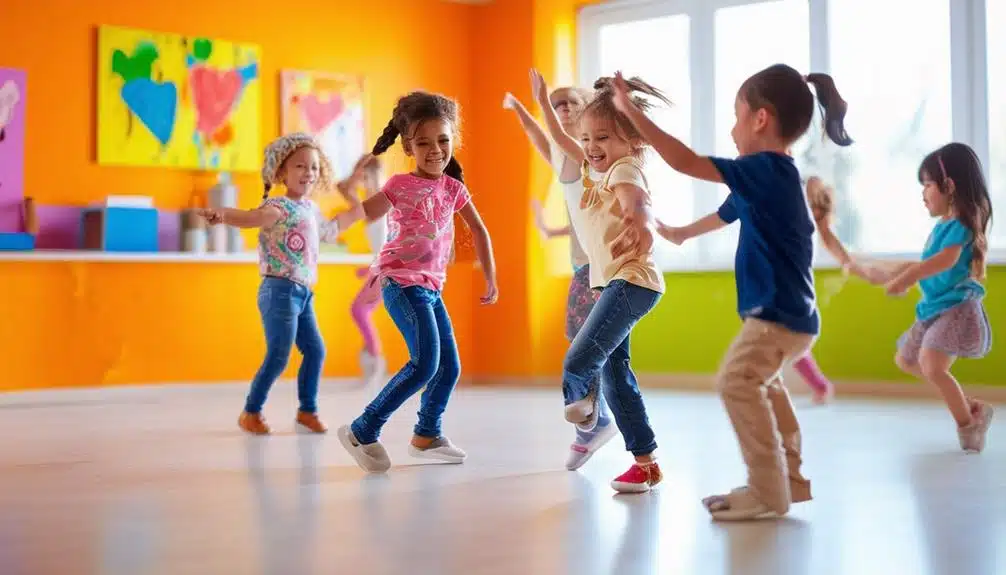
Although often overlooked, dancing is an incredibly effective activity that enhances coordination in children by necessitating precise movements to align with the rhythm of music. This rhythmic synchronization between movement and sound not only improves coordination but also helps in developing a keen sense of body awareness. Each dance step and pattern introduces the child to new ways of moving, fostering an understanding of spatial orientation.
As the child dances, they engage large muscle groups through actions such as jumping, spinning, and kicking, thereby building gross motor skills. This aspect of dancing makes it an efficient tool to stimulate the child’s physical development while maintaining an element of fun and creativity.
Dance classes serve as excellent platforms for structured practice. They offer a variety of activities designed to promote coordination and balance in a social and enjoyable setting. However, the benefits of dancing are not restricted to structured environments. Even freestyle dancing at home can be instrumental in enhancing motor skills. It allows children to express themselves creatively, further encouraging active participation. To sum up, dancing presents an engaging and versatile method to bolster coordination and gross motor skills in children aged 4 to 6.
Building Obstacle Courses
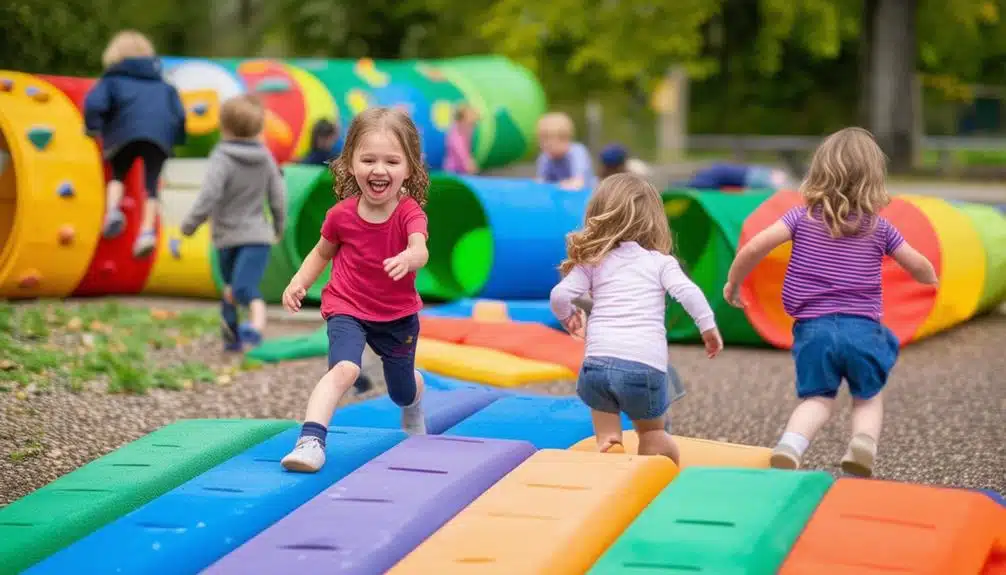
Engaging and stimulating obstacle courses serve as potent tools for promoting the development of gross motor skills in children aged four to six. These energetic and interactive activities encompass a variety of movements, such as crawling, jumping, balancing, and running. Each of these actions presents a distinct challenge to a child’s coordination and strength, thereby facilitating the enhancement of these essential physical abilities.
Customized obstacle courses, whether indoor or outdoor, can be created with relative ease. Household items and a touch of creativity can transform a living room or garden into a fun-filled arena that fosters growth in gross motor skills for 4-6-year-olds. From cushions and chairs to garden rocks and tree stumps, almost anything can be repurposed into an exciting obstacle.
Beyond the physical, obstacle courses also contribute to the development of other skill sets. They help children improve spatial awareness and problem-solving skills as they assess and navigate through the course. In addition, overcoming the challenges within these obstacle courses fosters confidence, perseverance, and a sense of achievement. This multi-faceted development makes building obstacle courses a highly beneficial activity for young children.
Importance of Gross Motor Skills
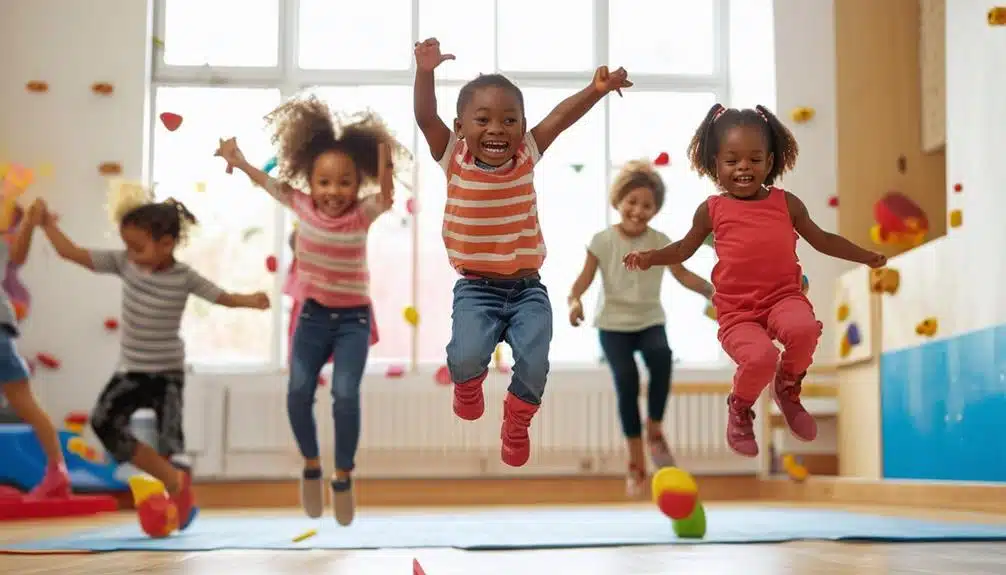
The development of gross motor skills plays an integral role in various aspects of a child’s life, including everyday activities, academic learning, and physical endurance. The importance of these skills extends far beyond basic physical activities; it is deeply intertwined with cognitive, psychological, and social development.
Developing gross motor skills is a fundamental part of children’s development and forms the basic building blocks for many vital abilities. They are essential for children to perform daily self-care tasks like dressing independently, tying shoelaces, or brushing their teeth. This ability boosts their confidence and fosters a sense of self-reliance.
Moreover, gross motor skills profoundly impact a child’s academic learning. Reasonable fine motor control can improve handwriting, while the ability to sit upright at a desk can increase concentration, reduce fatigue, and enhance learning outcomes.
Furthermore, gross motor skills are critical in promoting physical endurance. Children with well-developed gross motor skills can participate longer in physical activities and sports. This participation not only supports their physical health but also encourages social interaction and team-building skills.
In summary, the importance of gross motor skills in a child’s life includes:
- Facilitating everyday self-care tasks
- Enhancing academic learning
- Promoting physical activities and sports participation.
Building Blocks for Development
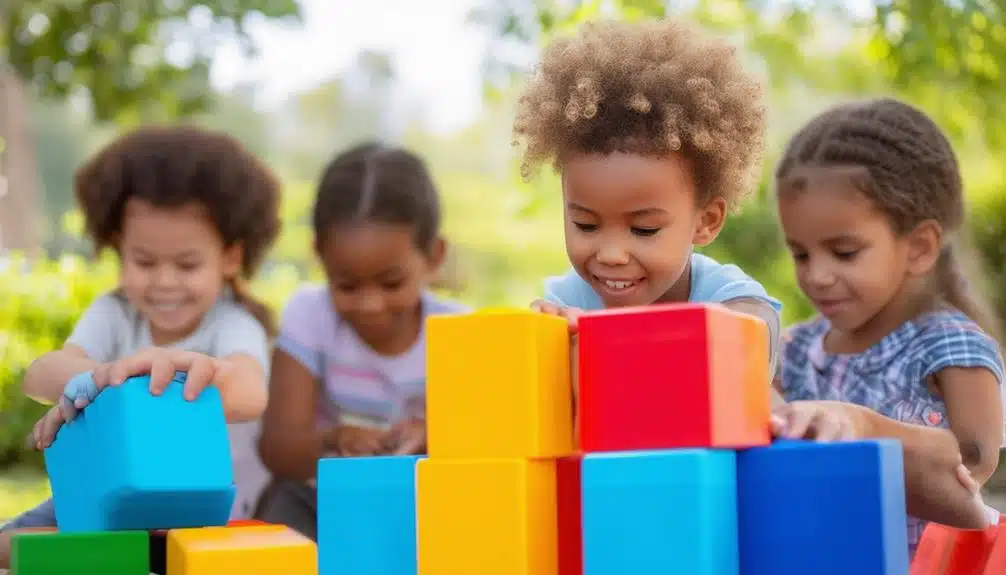
Understanding the building blocks for developing gross motor skills in children, especially those aged 4-6, is crucial, with muscular strength playing a pivotal role. This strength fostered through various gross motor skills activities, lays the foundation for physical development, enabling children to perform everyday tasks and engage in sports or outdoor play.
Another critical building block is motor planning, which involves the ability to sequence and coordinate movements. This ability is essential for children to move and interact with their environment effectively, improving their overall coordination and motor skills.
Proprioception, or the awareness of the body’s position and movement, is another critical building block. It provides children with a sense of space, helping them understand their bodies’ relation to the world around them. Activities that enhance proprioception can be beneficial in promoting balance, coordination, and spatial orientation.
Closely linked to proprioception is the concept of body awareness. This awareness allows children to understand and execute various movements, contributing significantly to their gross motor development. Incorporating exercises that enhance body awareness can improve their movement precision and control, laying the groundwork for more complex motor tasks as they mature.
Recognizing Gross Motor Difficulties
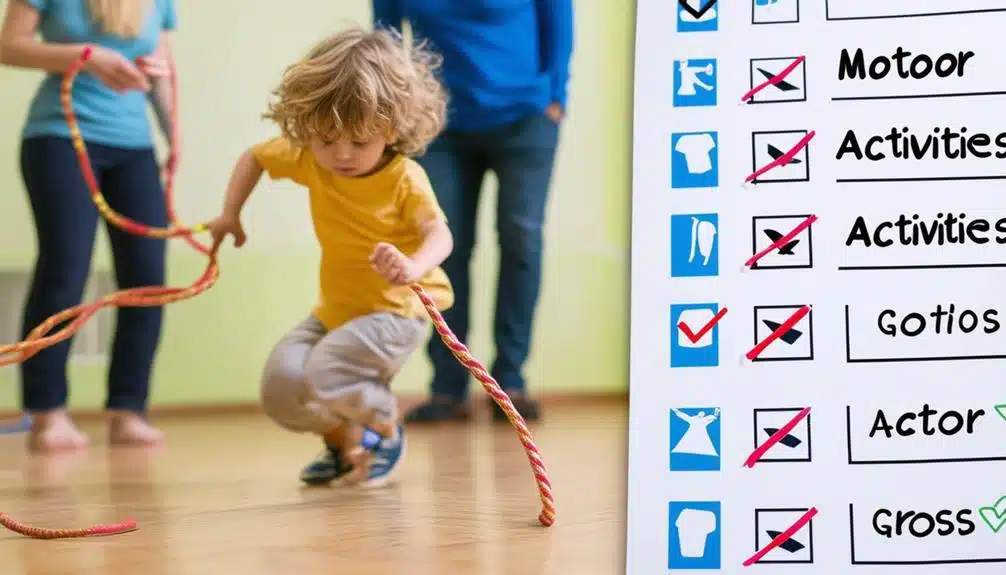
While nurturing gross motor skills in children aged 4-6 years is essential, it’s equally critical to recognize any difficulties or delays in their development. Recognizing these difficulties involves careful observations and a keen understanding of the milestones that children should typically achieve at this age.
Notable signs of gross motor difficulties include poor balance, coordination, and motor planning skills. These may manifest as a struggle with activities such as jumping, hopping, skipping, climbing stairs, riding a bike, or catching a ball. Certain behaviors could indicate possible challenges. If the child frequently avoids physical play, displays fatigue during physical activities, or exhibits consistent clumsiness, these may be signs of specific motor difficulties.
- Observe for delays in achieving milestones like jumping, hopping, and skipping.
- Look for signs such as poor balance, coordination, and motor planning skills.
- Note behaviors like avoiding physical play, fatigue during physical activities, or clumsiness.
It’s important to remember that each child’s development is individual. However, if these signs persist, a professional evaluation from an occupational therapist or physical therapist may be warranted to identify and address the challenges effectively.
Strategies for Motor Skills Improvement
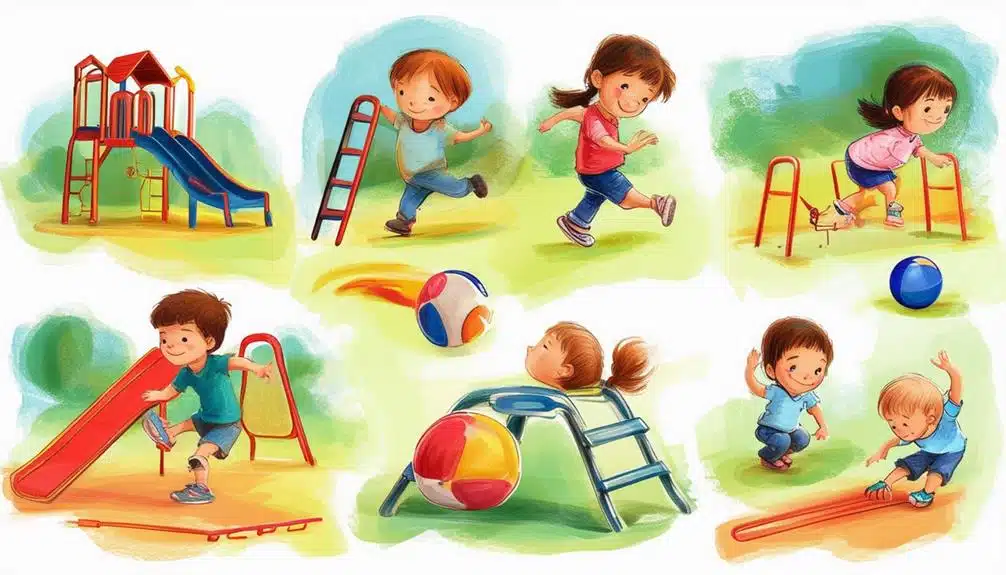
In order to foster the best development of gross motor skills in children aged 4-6 years, strategic engagement in activities such as dancing, obstacle courses, team games, and sensory pathways can play an important role. These activities not only enhance balance, coordination, and strength but also promote physical activity, social interaction, and cognitive development. A Gross Motor Activity such as dancing, for instance, can significantly improve body awareness and movement planning.
Outdoor gross motor activities like chalk hopscotch, hopscotch, and backyard twister can be instrumental in targeting balance, coordination, and motor skills development. In addition, activities like hula hoop games, bean bag toss, and relay races can improve coordination, agility, and hand-eye coordination, crucial aspects in developing gross motor skills.
Introducing homemade obstacle courses and games such as Simon Says and encouraging animal imitation games can foster body awareness and movement planning. These activities engage the child’s sensory processing abilities, further enhancing their gross motor skills. All these strategies aim to holistically develop the child’s motor skills, making them agile, coordinated, and physically confident.
Understanding Gross Motor Challenges
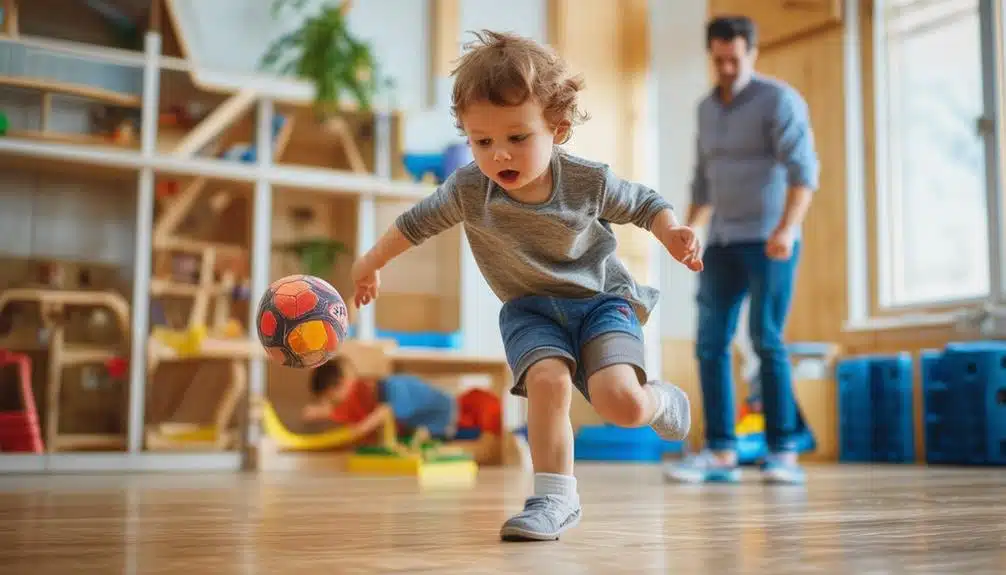
Gross motor challenges, prevalent among 4-6-year-olds, can present as issues with coordination, balance, and strength, influencing their ability to perform activities such as running, jumping, and sports engagement. This difficulty in achieving fluid, efficient movements not only hinders their physical skills but can also impact their self-confidence and enthusiasm to participate in active play.
These challenges can manifest in various ways, such as:
- Difficulty in coordinating movements, leading to clumsiness or frequent accidents.
- I am struggling to maintain balance, making activities like standing on one foot or hopping challenging.
- Lack of strength may limit their ability to perform tasks requiring muscle power, such as climbing stairs or throwing a ball.
Early identification and intervention are essential to addressing these gross motor challenges. By providing targeted activities and interventions, we can help children overcome these challenges and develop the necessary skills for smooth, coordinated movements. This, in turn, can help improve their overall physical abilities, confidence, and interest in physical activities. Understanding the nature of these challenges is the first step towards helping our children lead a more active, confident life.
Animal Imitation Games
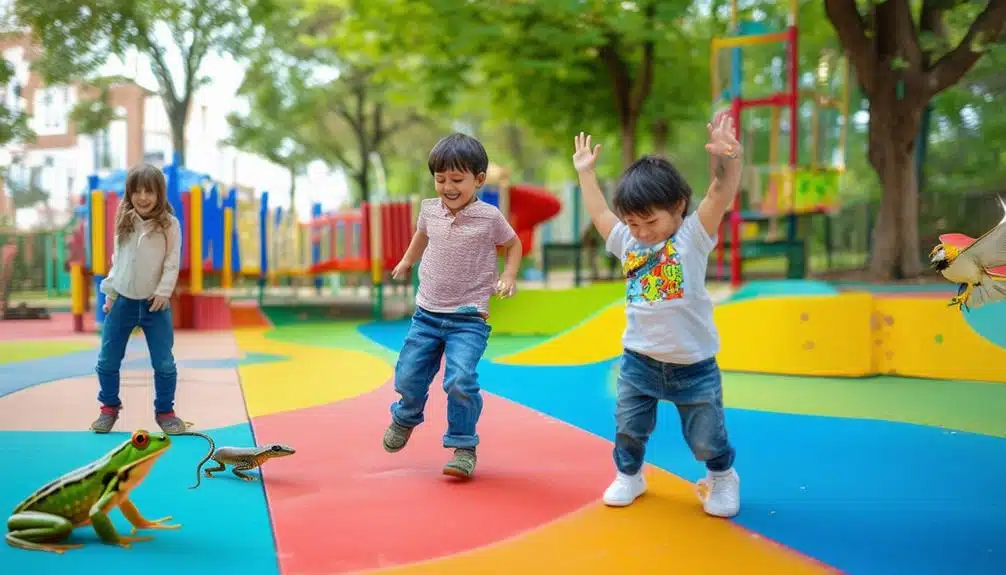
Building on the understanding of gross motor challenges, let’s explore the role of Animal Imitation Games in boosting these skills among 4-6-year-olds. These games, involving activities like hopping like a frog or strutting like a duck, are designed to enhance gross motor skills. By promoting physical movement and coordination through the imitation of animal actions, children can notably improve their overall physical development.
Animal Imitation Games are not just a source of enjoyment for children but also a platform to enhance balance and body awareness. For instance, crawling like a snake or swinging like a monkey can help children understand and manage their body movements better. These engaging activities lend themselves to the development of strength, balance, and coordination in a fun and imaginative manner.
Moreover, these games serve as an excellent way to engage children in gross motor activities, fostering creativity and imagination along the way. The beauty of Animal Imitation Games lies in their simplicity and versatility. They allow children to explore an array of movements, thus boosting their gross motor skills. Incorporating these games into a child’s routine can aid significantly in their physical development.
Engaging in Balance Challenges
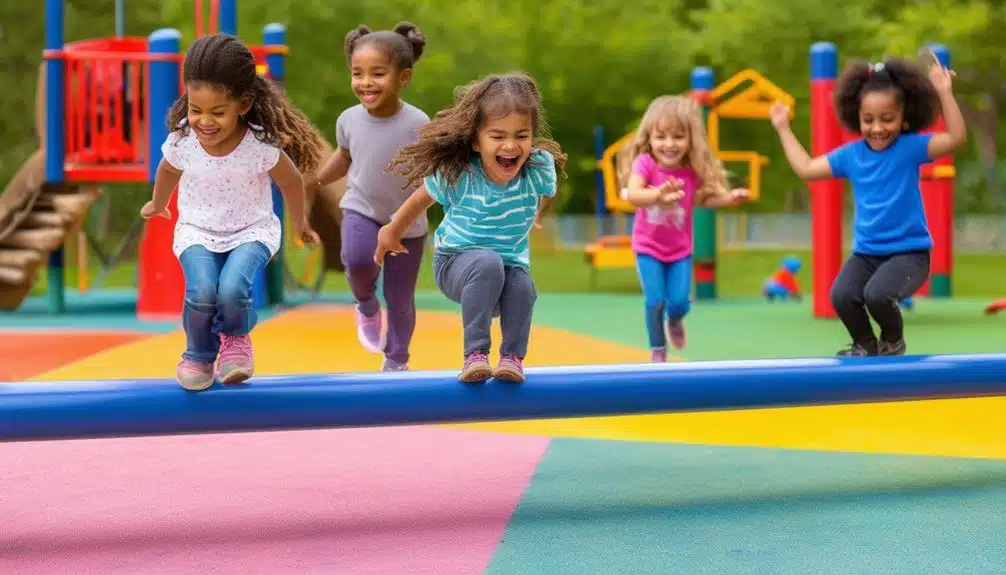
Shifting our focus to balance challenges, it’s worth noting that activities such as walking on a balance beam or standing on one leg significantly improve coordination, core strength, and proprioception in 4-6-year-olds. These challenges are essential in the acquisition of gross motor skills. Engaging in balanced activities not only enhances the child’s stability but also promotes body awareness, which is pivotal for their overall development.
Here are a few balance challenges suitable for this age group:
- Walking on a balance beam: This activity enhances coordination and core strength. It requires concentration, as children must keep their balance while walking on a narrow surface.
- Standing on one foot: This activity improves proprioception – the sense of self-movement and body position. It’s a fun challenge that can be made into a game, enhancing enjoyment while also developing essential skills.
- Walking a straight line: This simple yet effective game improves gross motor skills and balance. It can be easily set up with a piece of string or tape.
Regular practice of these balance challenges can improve coordination, increase physical confidence, and improve gross motor skills in young children.
Frequently Asked Questions
How can I encourage my child to join activities that boost gross motor skills?
Start by choosing fun, engaging activities like animal imitation games or balloon play that feel more like play than exercise. When kids enjoy the activity, they’re more likely to join in—and boosting gross motor skills can happen naturally while they have fun!
How Can I Help My 6-Year-Old With Gross Motor Skills?
Encourage outdoor play, simple exercises, and playground fun to boost your 6-year-old’s gross motor skills. Organize sports games or balance activities to improve coordination, agility, and strength, which are essential for their physical development.
What Are the Gross Motor Activities for 4-Year-Olds?
Outdoor games, indoor play, sensory activities, active sports, and imaginative play, like obstacle courses, Simon Says, and tricycle riding, are effective in enhancing gross motor skills in 4-year-olds.
What Is an Example of Strong Gross Motor Skills for a Four-Year-Old?
Four- to five-year-olds displaying gross solid motor skills proficiently perform running, jumping, climbing, balancing, swinging, kicking, throwing, catching, dancing, and hopping activities, showcasing enhanced coordination, agility, and confidence in their physical capabilities.
What Fine Motor Activities Are Good Practice for Children Ages Four to Six?
Fine motor activities for children ages four to six include manipulating play dough, developing scissor skills, practicing handwriting, beading activities for hand-eye coordination, and tasks to enhance pincer grasp, such as picking up small objects.
Conclusion
To sum up, gross motor skill development in children aged 4-6 is essential for their overall growth and learning. These 15 activities, ranging from trampoline exploration to balance challenges, not only enhance their physical abilities but also contribute to their cognitive and social development. As the saying goes, ‘practice makes perfect,’ and regular engagement in these activities can lead to significant enhancements in children’s gross motor skill proficiency.

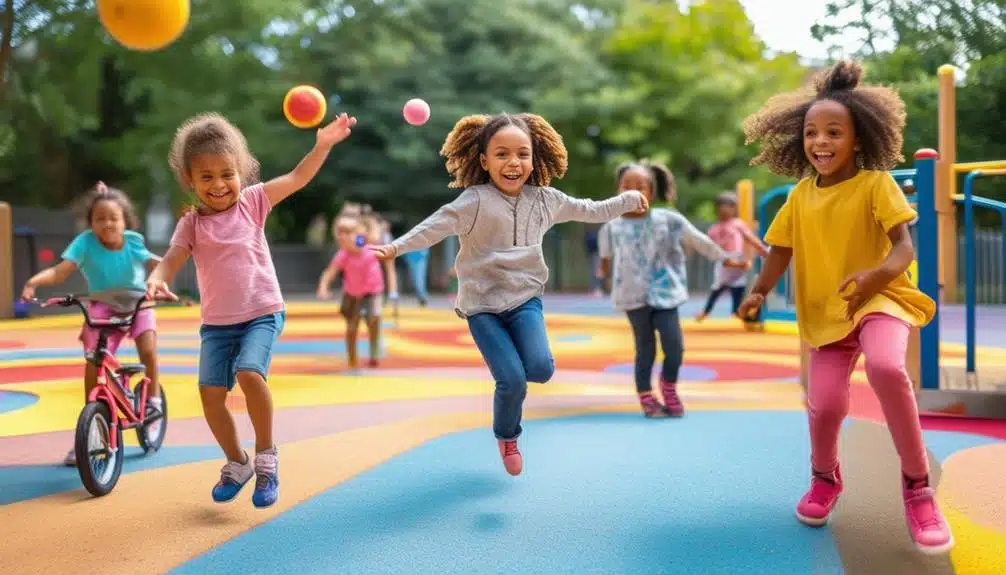
Recent Comments